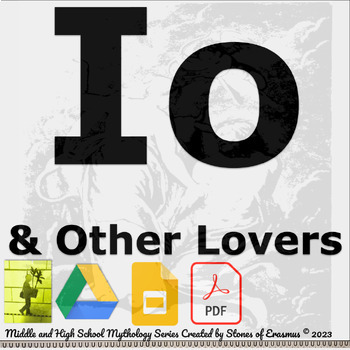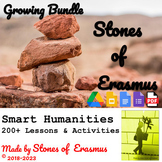Io and Other Lovers: Greek Mythology Lesson | High School ELA Digital & Print
- Google Drive™ folder
- Easel Activity
- Easel Assessment

Also included in
- Everything related to broadening the scope of a humanities curriculum for middle and high school is included in this growing bundle.☝211 and growing educational units! Entirely print + digital — Adobe Acrobat and Google Apps power each download. Extra addition: Includes free-to-use out-of-the-box EaPrice $590.00Original Price $906.85Save $316.85
Description
In the tapestry of Greek mythology, Io's story is a compelling narrative that intertwines the fates of gods and mortals. Central to her tale are the figures of Hera and Zeus, with Prometheus playing a pivotal role in the unfolding drama. Io, favored by Zeus, is turned into a heifer by him to hide their affair from Hera. Hera, not fooled, has Argus guard her. Zeus sends Hermes to rescue Io, leading Hera to pursue her with a gadfly. Io's travels and transformations symbolize resilience and the intricate god-mortal dynamics. Also included are the stories of Alpheus and Arethusa, Antiope, Callisto, Ceyx and Alcyone, and more!
This Resource Includes the Following Features:
- Access to Print and Digital Versions (PDF, Google Workspace, & Easel)
- Three-Day Lesson Calendar (with Teacher's Notes)
- Key Characters and Places Anchor Chart
- Orient learners by identifying the cast of characters and their relationship to each other and the gods.
- 6 Reading Cards — Designed to effectively combine mythological narratives with artistic representations, enhancing the educational value of the content.
- Io's Story (3 cards): The narrative of Io includes her transformation into a heifer by Zeus, Hera's response, and the involvement of Argus and Hermes. The card also correctly mentions Io's wandering and eventual restoration to human form.
- Alpheus and Arethusa: The story of Alpheus' pursuit of Arethusa and her transformation into a fountain is presented. The card captures the essence of their myth and the geographical implications. It also includes the sculpture by Battista di Domenico Lorenzi.
- Antiope (2 cards): The card features Antiope, her encounter with Zeus, and her connection to Theban legends.
- Callisto: The card portrays Callisto's story, including her transformation into a bear by Zeus and her placement in the stars as Ursa Major.
- Ceyx and Alcyone: The story of Ceyx and Alcyone includes their transformation into halcyon birds and the origin of the term "halcyon days."
- Nymphs: Also includes a section on nymphs and how they are historically represented in mythologies and Greek and Roman religions.
- Each card includes art and literature that depict these myths.
- 1 Note-taking template
- 19-count Question Bank
- Reading comprehension questions have a vocabulary in context, analysis, and inference questions.
- 2 Exit Tickets
- Exit tickets are a way to get data about your students' understanding of the lesson right before the class is finished. Collect these exit tickets and quickly see what your students have learned. I also provide two different tickets to offer academic choice for students.
- Frayer Model Vocabulary Template (with one student sample)
- Frayer models are a way to get kids to think about vocabulary visually in a four-section square — A square for meaning, one for examples, another for non-examples, and a sketch. It is impressive to see the work they produce. A great way to decorate your classroom to showcase your kids' vocabulary-in-text understanding. The cards can contain terms, geography, challenging words (as well as contextual entries that fit the story).
- 1 Further Reading List
- Don't disregard this further reading list if you think it is merely a bibliography. Share the list with your students or have them do projects based on the available research. Assign different sources to students and organize presentations where learning can go deeper into the story.
- Answer Key
I created this resource with middle and high school students in mind. It is designed for an English Language Arts Mythology unit —
- Part of a Larger Mythology Suite from Stones of Erasmus
- Hera (Juno)
- Zeus
- Zeus and Metis, First Consort
- Prometheus & Pandora
- Europa and the Bull
- Pygmalion and Galatea
- Use this resource as a stand-alone lesson or pair it with a larger unit on Gods and mortals, Ovid's Metamorphoses, Robert Graves's Greek Myths, or Edith Hamilton's Mythology.
Know that this educational digital download supplements a unit on Greek Mythology.
Special thanks to the New York Public Library Digital Collection for providing a rich deposit of out-of-copyright materials.
You can navigate your web browser to my website, Stones of Erasmus, to follow me. © 2023 stonesoferasmus.com







